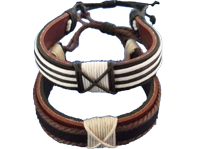 |
| fundraising bracelets |
I am yet to find one industry that hasn't be tainted in some way by the exploitation of workers. To this point fundraising is not exempt from this. In fact, the manufacturing of chocolate - the fundraiser of choice for many- has been one of the biggest offenders of unfair working conditions globally. While, the chocolate industry is currently going through an overhaul, there is still a long way to go before we can be assured that our food for "love" can be as it is claimed.
For that matter, the latex used to manufacture fundraising bracelets is also a bit of a "fair trade" mystery. With the majority of latex these days manufactured using petroleum, only about 25% of rubber is derived from forest plantations. Historically these plantations have been notorious for the way that they treat their workers, with large business' like goodyear leading the way in the mistreatment.
Today, however, much of the natural rubber is still made from trees in developing nations. While many of the plantations are run by family business, it is their claim that the working conditions are good and their employees are paid fairly for what they do. With no certification process in place for many of these manufacturers and understanding the heart of man, I find it difficult to believe that out of the goodness of their heart with no pressure from industry that a fair trading model would be established. Either the multinationals will be screwing the prices or the manufacturer would be pocketing the profit. It just doesn't add up with the history of man that anything but greed will be driving the economics of rubber.
So to this end, if you consider that how a product is made is important to your fundraising campaign, then it may be valuable to check out which ones follow a fair trading protocol. Now not all business have the "fair trade" label should be discounted. Sometimes you can simply ask "how do you make your product?" and "where does your product come from?" If they dont have a quick response to that questions, or they are a bit like Nike and try to avoid the answer, then it may be worth considering an alternative. I would certainly be dubious about any business that doesn't have a clear position on the working conditions of employees and sub-contractors.
If you would like to know more about how "fair trade" can be combined with a fundraising program, visit 1hope fundraising and check out their fundraising bracelets.
If you would like to know more about how "fair trade" can be combined with a fundraising program, visit 1hope fundraising and check out their fundraising bracelets.


